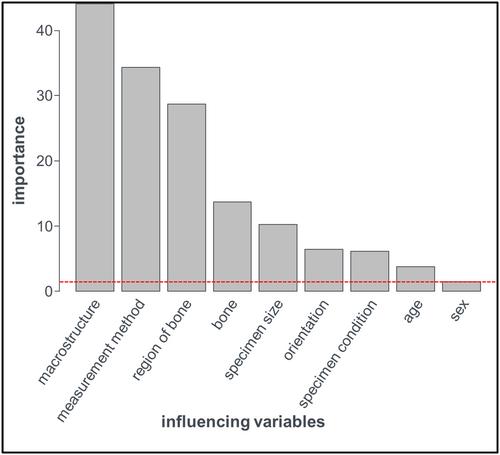下载PDF
{"title":"各向异性、解剖区域和其他变量对骨质杨氏模量的影响:系统综述与元分析","authors":"Krisztián Kovács, Szilárd Váncsa, Gergely Agócs, Andrea Harnos, Péter Hegyi, Viktor Weninger, Katinka Baross, Bence Kovács, Gergely Soós, György Kocsis","doi":"10.1002/jbm4.10835","DOIUrl":null,"url":null,"abstract":"<p>The importance of finite element analysis (FEA) is growing in orthopedic research, especially in implant design. However, Young's modulus (<i>E</i>) values, one of the most fundamental parameters, can range across a wide scale. Therefore, our study aimed to identify factors influencing <i>E</i> values in human bone specimens. We report our systematic review and meta-analysis based on the recommendation of the Preferred Reporting Items for Systematic Reviews and Meta-Analyses (PRISMA) 2020 guideline. We conducted the analysis on November 21, 2021. We included studies investigating healthy human bone specimens and reported on <i>E</i> values regarding demographic data, specimen characteristics, and measurement specifics. In addition, we included study types reporting individual specimen measurements. From the acquired data, we created a cohort in which we performed an exploratory data analysis that included the explanatory variables selected by random forest and regression trees methods, and the comparison of groups using independent samples Welch's <i>t</i> test. A total of 756 entries were included from 48 articles. Eleven different bones of the human body were included in these articles. The range of <i>E</i> values is between 0.008 and 33.7 GPa. The <i>E</i> values were most heavily influenced by the cortical or cancellous type of bone tested. Measuring method (compression, tension, bending, and nanoindentation), the anatomical region within a bone, the position of the bone within the skeleton, and the bone specimen size had a decreasing impact on the <i>E</i> values. Bone anisotropy, specimen condition, patient age, and sex were selected as important variables considering the value of <i>E</i>. On the basis of our results, <i>E</i> values of a bone change with bone characteristics, measurement techniques, and demographic variables. Therefore, the evaluation of FEA should be performed after the standardization of in vitro measurement protocol. © 2023 The Authors. <i>JBMR Plus</i> published by Wiley Periodicals LLC on behalf of American Society for Bone and Mineral Research.</p>","PeriodicalId":14611,"journal":{"name":"JBMR Plus","volume":"7 12","pages":""},"PeriodicalIF":3.4000,"publicationDate":"2023-10-31","publicationTypes":"Journal Article","fieldsOfStudy":null,"isOpenAccess":false,"openAccessPdf":"https://asbmr.onlinelibrary.wiley.com/doi/epdf/10.1002/jbm4.10835","citationCount":"0","resultStr":"{\"title\":\"Anisotropy, Anatomical Region, and Additional Variables Influence Young's Modulus of Bone: A Systematic Review and Meta-Analysis\",\"authors\":\"Krisztián Kovács, Szilárd Váncsa, Gergely Agócs, Andrea Harnos, Péter Hegyi, Viktor Weninger, Katinka Baross, Bence Kovács, Gergely Soós, György Kocsis\",\"doi\":\"10.1002/jbm4.10835\",\"DOIUrl\":null,\"url\":null,\"abstract\":\"<p>The importance of finite element analysis (FEA) is growing in orthopedic research, especially in implant design. However, Young's modulus (<i>E</i>) values, one of the most fundamental parameters, can range across a wide scale. Therefore, our study aimed to identify factors influencing <i>E</i> values in human bone specimens. We report our systematic review and meta-analysis based on the recommendation of the Preferred Reporting Items for Systematic Reviews and Meta-Analyses (PRISMA) 2020 guideline. We conducted the analysis on November 21, 2021. We included studies investigating healthy human bone specimens and reported on <i>E</i> values regarding demographic data, specimen characteristics, and measurement specifics. In addition, we included study types reporting individual specimen measurements. From the acquired data, we created a cohort in which we performed an exploratory data analysis that included the explanatory variables selected by random forest and regression trees methods, and the comparison of groups using independent samples Welch's <i>t</i> test. A total of 756 entries were included from 48 articles. Eleven different bones of the human body were included in these articles. The range of <i>E</i> values is between 0.008 and 33.7 GPa. The <i>E</i> values were most heavily influenced by the cortical or cancellous type of bone tested. Measuring method (compression, tension, bending, and nanoindentation), the anatomical region within a bone, the position of the bone within the skeleton, and the bone specimen size had a decreasing impact on the <i>E</i> values. Bone anisotropy, specimen condition, patient age, and sex were selected as important variables considering the value of <i>E</i>. On the basis of our results, <i>E</i> values of a bone change with bone characteristics, measurement techniques, and demographic variables. Therefore, the evaluation of FEA should be performed after the standardization of in vitro measurement protocol. © 2023 The Authors. <i>JBMR Plus</i> published by Wiley Periodicals LLC on behalf of American Society for Bone and Mineral Research.</p>\",\"PeriodicalId\":14611,\"journal\":{\"name\":\"JBMR Plus\",\"volume\":\"7 12\",\"pages\":\"\"},\"PeriodicalIF\":3.4000,\"publicationDate\":\"2023-10-31\",\"publicationTypes\":\"Journal Article\",\"fieldsOfStudy\":null,\"isOpenAccess\":false,\"openAccessPdf\":\"https://asbmr.onlinelibrary.wiley.com/doi/epdf/10.1002/jbm4.10835\",\"citationCount\":\"0\",\"resultStr\":null,\"platform\":\"Semanticscholar\",\"paperid\":null,\"PeriodicalName\":\"JBMR Plus\",\"FirstCategoryId\":\"1085\",\"ListUrlMain\":\"https://onlinelibrary.wiley.com/doi/10.1002/jbm4.10835\",\"RegionNum\":0,\"RegionCategory\":null,\"ArticlePicture\":[],\"TitleCN\":null,\"AbstractTextCN\":null,\"PMCID\":null,\"EPubDate\":\"\",\"PubModel\":\"\",\"JCR\":\"Q2\",\"JCRName\":\"ENDOCRINOLOGY & METABOLISM\",\"Score\":null,\"Total\":0}","platform":"Semanticscholar","paperid":null,"PeriodicalName":"JBMR Plus","FirstCategoryId":"1085","ListUrlMain":"https://onlinelibrary.wiley.com/doi/10.1002/jbm4.10835","RegionNum":0,"RegionCategory":null,"ArticlePicture":[],"TitleCN":null,"AbstractTextCN":null,"PMCID":null,"EPubDate":"","PubModel":"","JCR":"Q2","JCRName":"ENDOCRINOLOGY & METABOLISM","Score":null,"Total":0}
引用次数: 0
引用
批量引用



